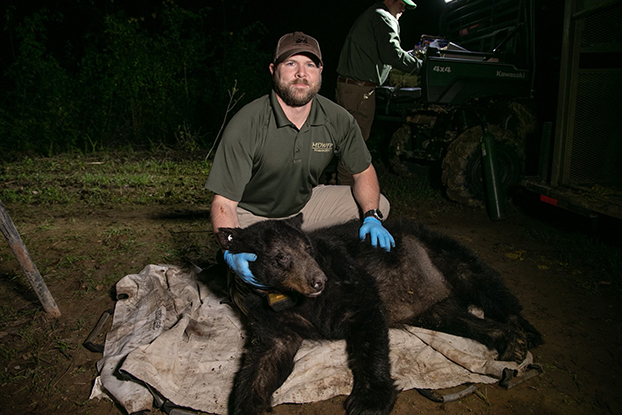Jefferson County bear contributing to research
Published 3:05 pm Wednesday, December 13, 2023

- Mississippi Department of Wildlife, Fisheries and Parks Bear Program coordinator Anthony Ballard collared this female bear in Jefferson County this month. It was initially collared by Louisiana Department of Wildlife and Fisheries in Tensas Parish. The bear will collect data for ongoing research projects. (Submitted Photo | MDWFP Bear Program)
RODNEY— A black bear in Jefferson County is now contributing to Mississippi Department of Wildlife, Fisheries and Parks research efforts. Anthony Ballard Jr, Bear Program Coordinator, said the bear was collared in early December.
Black bears are a native species to Mississippi and are starting to make a rebound in numbers. Unregulated over harvest, deforestation and habitat fragmentation hurt the black bear numbers in the early 1900s. Conservation efforts made progress in restoring the bear population as evidenced by the Louisiana Department of Wildlife and Fisheries working to create the first modern black bear hunting season. It is a similar population trajectory that quail, deer and turkeys have taken in Mississippi in the past 100 years.
Ballard said the female bear collared in Jefferson County was originally collared in Tensas Parish. He swapped the ear tags and collar to MDWFP equipment so Louisiana could get data it needs from the collar and get another female bear on air and contribute to research.
Trending
Ballard said the Louisiana Department of Wildlife and Fisheries estimated the bear to be between seven and nine years old in 2020 and he estimated her age to be 10 to 12 years old.
“We have two bears we know about that came from Louisiana. It is not uncommon for bears to come here,” Ballard said. “We knew about this bear and tried to catch up with her last den check season. A guy contacted me and said that she was in the area and we set a trap. We played cat and mouse for three weeks before trapping her. The Louisiana collar was close to dying.”
Ballard said the collar and its valuable research data was sent to LDWF and now the bear is collecting data for Mississippi to aid in answering a few research questions.
“Kudos to Louisiana. When you have an animal cross state lines frequently it is good to have a good woring relationship with them,”Ballard said. “We appreciate them for helping us out. We may need one of ours back at some point.”
One multi state research project is looking at genetic and spatial data to determine certain subpopulations in Arkansas, Tennessee, Mississippi and Louisiana. They are also looking at habitat selection and population modeling with the project.
Population modeling requires an understanding of the density, home range and how bears are arranged in the landscape.
Trending
“If you know certain home ranges and patterns it can put you in the direction to find out how many bears are in a given area,” Ballard said.
Lake Pickle with Primos Hunting and OnX, a mapping company, joined Ballard in placing the collar on the bear and gathering data.
Bear limiting factors
Ballard said historically bears have used bottomland hardwood forests as the “bread and butter,” of their home range due to the hard mast and den trees found there. Old growth cypress trees and old oaks with cavities are perfect den locations and can be found in bottomland systems.
Bears are versatile and stay mobile. They find other places to make dens on the sides of ridges, brush piles and dead trees outside of bottomland systems. Bears are abundant in Franklin County, 21 sightings, and are beginning to pop up across the state in more frequent sightings.
Ballard said there is ideal habitat and then habitat the bears can utilize. Habitat is not as much of a limiting factor as time is. Female black bears are able to breed every other year once they reach six years old and thus have a slow population growth biologically.
Mississippi’s black bears will likely play the same ecological role as they have done historically. They consume acorns and soft mass fruits dispersing the seeds and eat some meat. While habitat and populations have changed over time bears are still native and were never actually gone from Mississippi.
MDWFP reports 545 bear sightings since 2016 but the increase in sightings is partially due to an increase in public awareness. Ballard said the bear program will conduct den checks in March.




